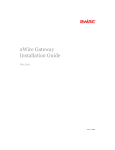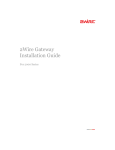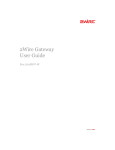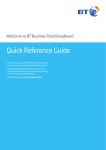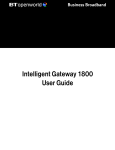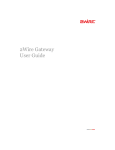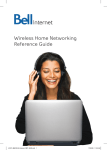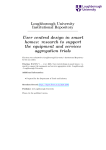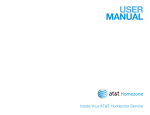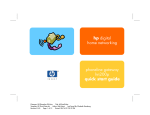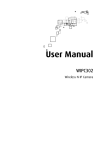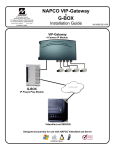Download 2Wire 2701HGV-W Owner's Manual
Transcript
2Wire Gateway Installation Guide For 2701HGV-W Notice to Users ©2008 2Wire, Inc. All rights reserved. This manual in whole or in part, may not be reproduced, translated, or reduced to any machinereadable form without prior written approval. 2WIRE PROVIDES NO WARRANTY WITH REGARD TO THIS MANUAL, THE SOFTWARE, OR OTHER INFORMATION CONTAINED HEREIN AND HEREBY EXPRESSLY DISCLAIMS ANY IMPLIED WARRANTIES OF MERCHANTABILITY OR FITNESS FOR ANY PARTICULAR PURPOSE WITH REGARD TO THIS MANUAL, THE SOFTWARE, OR SUCH OTHER INFORMATION, IN NO EVENT SHALL 2WIRE, INC. BE LIABLE FOR ANY INCIDENTAL, CONSEQUENTIAL, OR SPECIAL DAMAGES, WHETHER BASED ON TORT, CONTRACT, OR OTHERWISE, ARISING OUT OF OR IN CONNECTION WITH THIS MANUAL, THE SOFTWARE, OR OTHER INFORMATION CONTAINED HEREIN OR THE USE THEREOF. 2Wire, Inc. reserves the right to make any modification to this manual or the information contained herein at any time without notice. The software described herein is governed by the terms of a separate user license agreement. Updates and additions to software may require an additional charge. Subscriptions to online service providers may require a fee and credit card information. Financial services may require prior arrangements with participating financial institutions. 2Wire, the 2Wire logo, and HomePortal are registered trademarks, and HyperG, Greenlight, FullPass, and GuestPass are trademarks of 2Wire, Inc. All other trademarks are trademarks of their respective owners. 5100-000656-000 Rev A 08/2008 Contents Getting Started . . . . . . . . . . . . . . . . . . . . . . . . . . . . . . . . . . . . . . . . . . . . . . . . . . . . . 1 Remove or Disable Conflicting Applications . . . . . . . . . . . . . . . . . . . . . . . . . . . . . . . . . . 1 Check Your Computer’s Browser and System Requirements . . . . . . . . . . . . . . . . . . . . . . 1 Browser Requirements . . . . . . . . . . . . . . . . . . . . . . . . . . . . . . . . . . . . . . . . . . 1 System Requirements . . . . . . . . . . . . . . . . . . . . . . . . . . . . . . . . . . . . . . . . . . . 1 Connect the First Computer to the Gateway . . . . . . . . . . . . . . . . . . . . . . . . . . . . . . . . 2 Choose a Computer and Connection Type . . . . . . . . . . . . . . . . . . . . . . . . . . . . . . . . . . . 2 Install the DSL Filter . . . . . . . . . . . . . . . . . . . . . . . . . . . . . . . . . . . . . . . . . . . . . . . . . . 2 For Wall-Mounted Phones . . . . . . . . . . . . . . . . . . . . . . . . . . . . . . . . . . . . . . . . . 3 Ethernet Connection . . . . . . . . . . . . . . . . . . . . . . . . . . . . . . . . . . . . . . . . . . . . . . . . . . 4 Check Your Connections . . . . . . . . . . . . . . . . . . . . . . . . . . . . . . . . . . . . . . . . . 4 Wireless Connection . . . . . . . . . . . . . . . . . . . . . . . . . . . . . . . . . . . . . . . . . . . . . . . . . . 5 Non-2Wire Wireless Adapter Configuration . . . . . . . . . . . . . . . . . . . . . . . . . . . . . 6 USB Connection . . . . . . . . . . . . . . . . . . . . . . . . . . . . . . . . . . . . . . . . . . . . . . . . . . . . . 7 Install the 2Wire Gateway USB Driver - Windows . . . . . . . . . . . . . . . . . . . . . . . . 8 Install the 2Wire Gateway USB Driver - Macintosh . . . . . . . . . . . . . . . . . . . . . . . 8 Check Your Connections . . . . . . . . . . . . . . . . . . . . . . . . . . . . . . . . . . . . . . . . . 8 Run the 2Wire Setup Wizard . . . . . . . . . . . . . . . . . . . . . . . . . . . . . . . . . . . . . . . . . . . . 9 Windows XP/2K/ME/98SE . . . . . . . . . . . . . . . . . . . . . . . . . . . . . . . . . . . . . . . . . . . . . 9 Macintosh OS 10.1.4/10.1.5/10.2.0 - 10.2.8/10.3.3 - 10.3.8 . . . . . . . . . . . . . . . . . . . 9 Add Computers to the Network . . . . . . . . . . . . . . . . . . . . . . . . . . . . . . . . . . . . . . . . . . 10 Ethernet Connection . . . . . . . . . . . . . . . . . . . . . . . . . . . . . . . . . . . . . . . . . . . . . . . . . . 11 USB Connection . . . . . . . . . . . . . . . . . . . . . . . . . . . . . . . . . . . . . . . . . . . . . . . . . . . . . 12 Wireless Connection . . . . . . . . . . . . . . . . . . . . . . . . . . . . . . . . . . . . . . . . . . . . . . . . . . 13 Diagnostics . . . . . . . . . . . . . . . . . . . . . . . . . . . . . . . . . . . . . . . . . . . . . . . . . . . . . . . . 14 Understanding Broadband Redirect Messages . . . . . . . . . . . . . . . . . . . . . . . . . . . . . . . . 14 Excessive Sessions Warning . . . . . . . . . . . . . . . . . . . . . . . . . . . . . . . . . . . . . . 14 Invalid Customer Information (PPP) . . . . . . . . . . . . . . . . . . . . . . . . . . . . . . . . . . 14 No DSL Connection - Unable to Train . . . . . . . . . . . . . . . . . . . . . . . . . . . . . . . . 15 Intermittent Connection Issue - Uncanceled Echo . . . . . . . . . . . . . . . . . . . . . . . . 15 Broadband Link is Currently Not Available - DSL Connection Issue . . . . . . . . . . . 16 Broadband Link is Currently Not Available - Connection Error . . . . . . . . . . . . . . . 16 Router Behind Router Detected . . . . . . . . . . . . . . . . . . . . . . . . . . . . . . . . . . . . 17 Provision Gateway . . . . . . . . . . . . . . . . . . . . . . . . . . . . . . . . . . . . . . . . . . . . . . 17 Understanding the Indicator Lights . . . . . . . . . . . . . . . . . . . . . . . . . . . . . . . . . . . . . . . . 18 Appendix A: Install the Gateway on Other Operating Systems . . . . . . . . . . . . . . . . . . . 20 Ethernet Connection . . . . . . . . . . . . . . . . . . . . . . . . . . . . . . . . . . . . . . . . . . . . . . . . . . 20 USB Connection . . . . . . . . . . . . . . . . . . . . . . . . . . . . . . . . . . . . . . . . . . . . . . . . . . . . . 21 Configuring the Internet Connection . . . . . . . . . . . . . . . . . . . . . . . . . . . . . . . . . 22 Regulatory Information . . . . . . . . . . . . . . . . . . . . . . . . . . . . . . . . . . . . . . . . . . . . . . . . 23 Getting Started Remove or Disable Conflicting Applications Internet sharing software and PC based firewall applications typically interfere with the 2Wire gateway, and should be removed or disabled before you install the gateway. The 2Wire gateway provides the same features as the products listed below. If you have any of the following (or similar) applications installed on your computers, remove or disable them according to the manufacturer’s instructions before proceeding. Internet Sharing Applications Proxy Software Security Software Microsoft Internet Connection Sharing Wingate Norton Internet Security Intel Anypoint ISS Sygate Black Ice 3Com HomeClick Zone Alarm Check Your Computer’s Browser and System Requirements Verify that your computers meet the following minimum requirements: Browser Requirements Windows: Microsoft Internet Explorer 5.5 or higher (included on the 2Wire CD), Netscape Navigator 4.7 or higher, or Firefox 1.0 or higher. Macintosh: Safari 1.0, Microsoft Internet Explorer 5.0, or Netscape 4.74 or higher. System Requirements • 5 MB of available hard disk space for 2Wire gateway software. • Windows XP, Windows 2000, Windows NT 4.0 with Service Pack 6, Windows ME, Windows 98/98SE, or Mac OS 8.6 or higher. • Network adapter (such as Ethernet, USB, or 802.11b/g wireless). 1 Connect the First Computer to the Gateway Congratulations on the purchase of your 2Wire gateway. To install your gateway and configure your network, follow these steps. Note: Features for different models may vary. Product details will be specified for each particular model. Choose a Computer and Connection Type There are many ways to set up your network, but typically the first computer is located in the same room as the gateway and your DSL connection. Ethernet is the preferred connection method for your first computer, although instructions for connecting via wireless and USB are also provided. The first computer you connect to the network is used to configure the 2Wire gateway for proper operation. Choose one of the following methods to connect your first computer to the gateway. Save and close all open programs before you begin connecting your gateway. Connection Type Page Ethernet page 4 Wireless page 5 USB page 7 Install the DSL Filter Note: New DSL customers only. Existing DSL customers with filters already installed should proceed to Ethernet Connection on page 4, Wireless Connection on page 5, or USB Connection on page 7. Regular telephone and Digital Subscriber Line (DSL) signals are carried over the same line. Converting your regular telephone line to DSL can cause high-pitched tones and static when using the phone. Installing a filter on every telephone or telephone device sharing the same telephone number as your DSL1 separates these signals and eliminates the noise. 1. Do not install DSL filters if your telephone line is only carrying a DSL signal. 2 Connect the First Computer to the Gateway To install the DSL filter: 1. Locate the phone jack where you want to connect your 2Wire gateway. 2. Insert the DSL filter into the jack. 3. If you have a phone, answering machine, fax machine, satellite TV equipment, or other phone device in this jack location, plug it into the filter port labeled PHONE. 4. Install a DSL filter on all other phone devices in your house (such as dial-up modems, fax machines, caller ID devices, and set top boxes). Plug each of these devices into the filter port labeled PHONE. For Wall-Mounted Phones If you have a wall-mounted telephone, install a wall-mount DSL filter following these steps. 1. Lift the telephone from the wall pegs and disconnect the phone cord from the wall jack. 2. Connect the telephone cord from the back of the DSL filter into the wall jack. Align the keyhole slots on the filter with the wall plate pegs and press down gently to secure. 3. Connect the telephone cord to the phone jack located on the front of the mounted filter. 4. Attach the telephone to the mounting pegs on the DSL filter and your installation is complete. Note: The extra phone jack located at the bottom of the filter (labeled LINE) is provided should you wish to connect your gateway at this phone connection. 3 Connect the First Computer to the Gateway Ethernet Connection Figure 1. Gateway Connected Via Ethernet 1. Connect the provided power adapter from the gateway’s POWER port to an electrical outlet. The POWER light on the front of the gateway should be green. 2. Connect the provided gray phone cable from the gateway’s PHONE LINE port to the DSL filter jack labeled DSL/HPNA. 3. Connect the yellow Ethernet cable provided with the gateway from any available LOCAL ETHERNET port on the gateway to your computer’s Ethernet port. Check Your Connections With your computer completely started, verify the POWER and ETHERNET indicator lights on the front of the 2Wire gateway are green. If they are not, see “Understanding the Indicator Lights” on page 18. The INTERNET indicator light will not turn green until the gateway software has been installed and an Internet connection has been established. 4 Connect the First Computer to the Gateway Wireless Connection Requires wireless-enabled notebook or a computer with an 802.11b/g wireless network adapter installed. Wireless adapters can be purchased from your service provider. Note: Security of the 802.11g wireless connection associated with this 2Wire 2701HGV-W ADSL2+ Router is the customer’s responsibility. Telecom will take no responsibility for charges made to customer’s accounts due to poorly organized wireless security allowing unknown users to connect to the internet via this wireless router. Should this occur, do not complain to the Telecom Fault Service or Jetstream Helpdesk. Figure 2. Gateway Connected Via Wireless 1. Connect the provided AC power adapter from the 2Wire gateway’s POWER port to an electrical outlet. The POWER light on the front of the gateway should be green. 2. Connect the provided gray telephone cable from the gateway’s PHONE LINE port to a telephone jack with DSL service. 3. Install your wireless adapter according to the manufacturer’s instructions (see note below). Note: If you use a 2Wire wireless adapter (PC card or USB adapter) for wireless networking, the 2Wire CD automatically configures it to communicate with the gateway during setup. If you are NOT using a 2Wire wireless adapter, you must manually configure your adapter to communicate with the gateway using the information on page 6. 5 Connect the First Computer to the Gateway Non-2Wire Wireless Adapter Configuration Locating the Serial Number and Wireless Encryption Key The serial number of your 2Wire gateway is used as the network name (SSID). Beneath the serial number is a ten-digit number which is used as the encryption key. These are located on the bottom of your gateway (shown in horizontal orientation). You will need this information to configure your wireless adapter. Configuring the Adapter 1. Install and configure your wireless adapter according to the manufacturer’s instructions. 2. Use the network adapter configuration software or Windows network connection wizard to set the network name (SSID) and encryption key (WEP). a. The network name is the word “2WIRE” (in all capital letters), followed by the last three digits of the gateway serial number (for example, 2WIRE110). b. The encryption key is a 64-bit hex value, located beneath the bar code on the bottom of the 2Wire gateway. In the example, it is 4119627022. c. For Mac OS X users, you may need to enter the “$” character at the beginning of the encryption key (for example, $4119627022). 6 Connect the First Computer to the Gateway USB Connection Figure 3. Gateway Connected Via USB 1. Connect the provided AC power adapter from the 2Wire gateway’s POWER port to an electrical outlet. The POWER light on the front of the gateway should be green. 2. Connect the provided blue USB cable from the gateway’s USB port to the USB port on your computer. 3. Connect the provided gray telephone cable from the gateway’s PHONE LINE port to a telephone jack with DSL service. 7 Connect the First Computer to the Gateway Install the 2Wire Gateway USB Driver - Windows 1. Power on your computer and place the 2Wire CD in your computer’s CD-ROM drive. 2. If the Add Hardware Wizard displays, follow the on-screen instructions. If prompted to identify where to search for drivers, deselect Floppy Disk drive and check CD-ROM drive. 3. After the driver installs click Finish to complete the driver installation. The Setup Wizard will resume when your PC has rebooted. Note: Microsoft Windows 98 users may be prompted to insert the Windows 98 installation CD-ROM after installing the 2Wire gateway USB drivers. After the Windows 98 updates are complete, remove the Windows 98 CD and reinsert the 2Wire CD into your CD-ROM prior to rebooting your PC. Install the 2Wire Gateway USB Driver - Macintosh Note: The 2Wire gateway supports USB for Macintosh OS 8.6, 9.2, 10.1.4, 10.1.5, 10.2.0, 10.2.1 to 10.2.6, 10.3.3 to 10.3.9, 10.4.0, and 10.4.1. Before making your USB connection to the gateway, you must install the 2Wire gateway USB driver on your computer. The following instructions are for USB installation on Macintosh computers running OS 10.2. 1. Power on your computer and place the 2Wire CD in your computer’s CD-ROM drive. 2. Double-click the 2Wire CD icon on your desktop. 3. Double-click 2Wire USB to begin the driver installation. 4. If you have set up an administrator name and password, the Authenticate screen opens. Enter your administrator name and password and click OK. 5. Follow the on-screen instructions. When the driver installation is complete, you will be prompted to restart your computer. 6. After your computer restarts, connect the provided blue USB cable from the USB-PC port on the 2Wire gateway to your computer’s USB port. Check Your Connections With your computer completely started, verify the POWER and USB-PC indicator lights on the front of the 2Wire gateway are green. If they are not, see “Understanding the Indicator Lights” on page 18. The INTERNET indicator light will not turn green until the gateway software has been installed and an Internet connection has been established. 8 Run the 2Wire Setup Wizard Windows XP/2K/ME/98SE 1. 2. Insert the 2Wire CD and follow the on-screen instructions. If the 2Wire Setup Wizard does not automatically start: − Double-click the My Computer icon located on the desktop. − Double-click the icon that corresponds to your CD-ROM drive. − Double-click Setup.exe and follow the on-screen instructions. If prompted by the Setup Wizard, enter the 20-digit key code you received from your service provider. If you were not provided with a key code, contact your service provider. Macintosh OS 10.1.4/10.1.5/10.2.0 - 10.2.8/10.3.3 - 10.3.8 Note: MAC OS 9.X AND OTHER OPERATING SYSTEM USERS: Users running Mac OS 9.X and operating systems other than those stated above must perform a manual configuration of the gateway. Refer to “Appendix A: Install the Gateway on Other Operating Systems” on page 20 for step-by-step instructions. 1. Insert the 2Wire CD. 2. Double-click the 2Wire icon. 3. Double-click the 2Wire Setup Wizard icon. 4. If prompted by the Setup Wizard, enter the 20-digit key code you received from your service provider. If you were not provided with a key code, contact your service provider. 9 Add Computers to the Network After your first computer is connected to the 2Wire gateway and your Internet connection has been established, you can connect other computers to the network. Use any of the following methods to connect additional computers to your network. Connection Type Page Ethernet page 11 USB page 12 Wireless page 13 10 Add Computers to the Network Ethernet Connection Figure 4. Gateway Connected to Second Computer Via Ethernet 1. Connect an Ethernet cable from the any available LOCAL ETHERNET1 port on the gateway to your computer’s Ethernet port. 1. The number of Ethernet ports vary by model (from one to four). If your gateway has four Ethernet ports, you can connect up to four computers to your network via Ethernet. 11 Add Computers to the Network USB Connection Figure 5. Gateway Connected to Second Computer Via USB 1. Connect the provided blue USB cable from the gateway’s USB-PC port to the USB port on your computer. 2. Install the USB driver (refer to page 8 for instructions). 3. Repeat “Run the 2Wire Setup Wizard” on page 9. 12 Add Computers to the Network Wireless Connection Figure 6. Gateway Connected to Second Computer Via Wireless Requires a computer with an 802.11b/g wireless network adapter installed. Wireless adapters are purchased separately from the 2Wire gateway. Note: If you use a 2Wire wireless adapter (PCI, PC card, or USB adapter) for wireless networking, the gateway installation software automatically configures it to communicate with the gateway during setup. If you are NOT using a 2Wire wireless adapter, you must manually configure your adapter to communicate with the gateway using the information on page 6. Note: Security of the 802.11g wireless connection associated with this 2Wire 2701HGV-W ADSL2+ Router is the customer’s responsibility. Telecom will take no responsibility for charges made to customer’s accounts due to poorly organized wireless security allowing unknown users to connect to the internet via this wireless router. Should this occur, do not complain to the Telecom Fault Service or Jetstream Helpdesk. 1. Install your wireless adapter according to the manufacturer’s instructions (see note above). 2. Repeat “Run the 2Wire Setup Wizard” on page 9. 13 Diagnostics Note: Broadband Redirect Messages are visible only if they have been enabled by your service provider, and the physical appearance may vary from the examples shown. Understanding Broadband Redirect Messages If the 2Wire gateway detects a connection problem or an intermittent service error, it generates an error or alert (Broadband Redirect Message) and displays the message within your Web browser. The following messages contain information that can help you resolve some of the most common installation or network conflicts. Excessive Sessions Warning This error message typically occurs when your PC has been infected with the Blaster Virus or similar agent. The error message appears because too many simultaneous Internet sessions are opened, which impairs both network and PC performance. Check the PC with an anti-virus program using the latest virus updates to identify and remove the infection. There may be cases where certain applications running on a PC mimic the excessive session characteristics, creating a false positive error condition. If you are certain that no viruses are present on the PC, enable the Do not show me excessive session warnings in the future checkbox. Invalid Customer Information (PPP) This error message results from an incorrect PPP username and/or password. Click the Set Up Now button to re-enter the correct PPP information and attempt to connect to the broadband network. 14 Diagnostics No DSL Connection - Unable to Train When setting up a DSL broadband network, all active phone devices must have a phone line filter installed. Without the filter, the DSL connection will be unstable, resulting in a poor or no DSL connection. If phone line filters are missing, line noise and/or echo can affect the DSL connection. This error message occurs when the noise level is so high that the gateway cannot establish a DSL connection. To resolve this problem, inspect all active phone connections (including home security systems, fax machines, etc.) and verify that all devices have a phone line filter installed. Once all phone lines are properly filtered, try to connect to the broadband network. Intermittent Connection Issue - Uncanceled Echo When setting up a DSL broadband network, all active phone devices must have a phone line filter installed. Without the filter, the DSL connection will be unstable, resulting in a poor or no DSL connection. If phone line filters are missing, line noise and/or echo can affect the DSL connection. This error message occurs when the noise level is so high that it impacts the quality of your DSL broadband connection. To resolve this problem, inspect all active phone connections (including home security systems, fax machines, etc.) and verify that all devices have a phone line filter installed. Once all phone lines are properly filtered, try to connect to the broadband network. 15 Diagnostics Broadband Link is Currently Not Available - DSL Connection Issue This error message is displayed because the gateway was unable to establish a broadband network connection. Check to ensure that all cables are correctly connected, and the cable end securely attached to the port. In addition, verify that you are connecting on or after the date specified by your service provider for DSL service availability. Broadband Link is Currently Not Available - Connection Error The gateway was unable to communicate with the service provider network. This could be due to failed network equipment or a temporary outage. When the Internet light on the gateway is green, attempt to connect to the DSL network. 16 Diagnostics Router Behind Router Detected If the gateway detects the presence of a third-party router, the Router Behind Router error page displays. If a third-party router is connected to the 2Wire gateway, network instability can result because both devices are trying to manage private IPs via NAT. The best solution is to remove the third-party router from your LAN since the 2Wire gateway can manage your home network. If this option is not acceptable, move the third-party router to DMZPlus Mode by clicking the Resolve button.. Note: DMZplus is a special firewall mode that is used for hosting applications. When in DMZplus mode, the designated computer shares your gateway’s IP address (Router Address), appears as if it is directly connected to the Internet, has all of the unassigned TCP and UDP ports opened and pointed to it, and can receive unsolicited network traffic from the Internet. Because all filtered traffic is forwarded to the designated computer, DMZplus mode should be used with caution. A computer in DMZplus mode is less secure because all available ports are open and all incoming Internet traffic is directed to this computer. Provision Gateway This error message is displayed if you attempt to access the Internet before configuring your gateway with the correct PPP credentials (username and password). Click the Set Up Now button to enter the PPP username and password provided to you by your service provider. After you have completed this process, you should be able to access the Internet. 17 Diagnostics Understanding the Indicator Lights The 2Wire gateway has numerous indicator lights that can be used to diagnose installation and connection problems. The following table describes how to interpret the indicator lights. Power Light Operating State OFF The gateway is not getting power. Blinking green (slow) The gateway is undergoing POST (power-on self test). Solid green Power is on. Blinking orange The gateway is undergoing a software upgrade. Solid red System error. Contact Technical Support. Ethernet, USB, or Wireless Light Operating State OFF The gateway is powered off or booting up. Solid green Device(s) connected via Ethernet, USB, or Wireless. Flickering green Data traffic is coming into or going out from the network. 18 Diagnostics Phone Lights Operating State Not used on this model Not used on this model DSL Light Operating State OFF The gateway is powered off or booting up. Blinking green (slow) The gateway is attempting to establish a connection to your broadband service(s). Blinking green (fast) The gateway has been unable to connect to the DSL signal for more than three minutes. Solid green The gateway is fully connected to your broadband service(s). Internet Light Operating State OFF The gateway has been unable to detect a DSL signal. DSL signal detected; the gateway is attempting to train. Blinking green (fast) The gateway is attempting to establish a connection to your broadband service(s). Solid red The gateway cannot connect to your broadband service. 19 Appendix A: Install the Gateway on Other Operating Systems Follow these instructions if you are using an operating system that is not supported by the 2Wire CD (such as any Macintosh OS prior to 10.2, UNIX, or Linux). There are many ways to set up your network, but typically the first computer is located in the same room as the gateway and your DSL connection. Ethernet is the preferred connection method for your first computer, although instructions for connecting via USB are also provided. Ethernet Connection Figure 7. Gateway Connected Via Ethernet (Macintosh) 1. Install DSL phone filters according to the instructions on page 2. 2. Connect the provided power adapter from the gateway’s POWER port to an electrical outlet. 3. Connect the provided gray phone cable from the gateway’s PHONE LINE port to the DSL filter jack labeled DSL/HPNA. 20 Appendix A: Install the Gateway on Other Operating Systems 4. Connect the yellow Ethernet cable provided with the gateway from a LOCAL ETHERNET port on the gateway to your computer’s Ethernet port. 5. Proceed to “Configuring the Internet Connection” on page 22. USB Connection Note: Connecting your computer to the gateway using USB requires an available USB port. Only one Windows or Macintosh computer can be directly connected to the 2Wire gateway using the USB connection. The following instructions are for Macintosh computers running OS 9.x. Figure 8. Gateway Connected Via USB (Macintosh) 1. Install DSL phone filters according to the instructions on page 2. 2. Insert the 2Wire CD in the computer’s CD-ROM drive. 3. Double-click the 2Wire CD icon on your desktop. 4. Double-click 2Wire USB to begin the driver installation. 5. If you have set up an administrator name and password, the Authenticate screen opens. Enter your administrator name and password and click OK. 21 Appendix A: Install the Gateway on Other Operating Systems 6. Follow the on-screen instructions. When the driver installation is complete, you will be prompted to restart your computer. 7. After your computer restarts, connect the provided blue USB cable from the USB-PC port on the 2Wire gateway to your computer’s USB port. 8. Open the network Control Panel by selecting the Apple icon > Control Panel > TCP/IP. 9. Verify that “Connect Via: 2Wire USB Remote NDIS…” is selected to set the network adapter as active. 10. Click Save to complete your installation. 11. Proceed to “Configuring the Internet Connection” on page 22. Configuring the Internet Connection Now that your first computer is connected to the gateway, you need to configure your gateway to communicate with your Internet service provider. To activate your Internet account: 1. Open your Internet browser. 2. Type http://gateway.2wire.net/setup into the browser’s address line. 3. When prompted to enter a key code, enter the key code provided by your Internet service in the key code field, and click NEXT. 4. Select your Local Time Zone and click NEXT. 5. You may be prompted to enter service provider information such as username and password. Enter any required service provider information and click NEXT. 6. The connection process will begin. During this process the INTERNET light on the front of the gateway will first blink green then turn solid green. This step could take up to five minutes as the gateway searches for your broadband service. 7. The gateway will now connect to the Internet. This process may take several minutes. If the registration screen opens, click the REGISTER button and complete the 2Wire registration process. 22 Regulatory Information Electrical AC Adapter The AC adapter is designed to ensure your personal safety and to be compatible with this equipment. Please follow these guidelines: • Do not use the adapter in a high moisture environment. Never touch the adapter when your hands or feet are wet. • Allow adequate ventilation around the adapter. Avoid locations with restricted airflow. • Connect the adapter to a proper power source. Voltage and grounding requirements are found on the product case and/or packaging. • Do not use the adapter if the cord becomes damaged. • Do not attempt to service the adapter. There are no serviceable parts inside. Replace the unit if it is damaged or exposed to excess moisture. Telecommunication Cord CAUTION: To reduce the risk of fire, use only No. 26 AWG or larger UL Listed or CSA Certified Telecommunication Line Cord. Location – Electrical Considerations WARNING: The electrical cord of this product must be plugged into a properly grounded outlet or adapter. Failure to comply could result in an electric shock hazard. If you do not know whether your outlet or adapter is properly grounded, you should consult a licensed electrician. CAUTION: Due to risk of electrical shock or terminal damage, do not use the terminal near water, including a bathtub, wash bowl, kitchen sink or laundry tub, in a wet basement, or near a swimming pool. Also, avoid using this product during electrical storms. Avoid locations near electrical appliances or other devices that cause excessive voltage fluctuations or emit electrical noise (for example, air conditioners, neon signs, high-frequency or magnetic security devices, or electric motors). Equipment Repairs Do not, under any circumstances, attempt any service, adjustments, or repairs on this equipment. Instead, contact your local 2Wire distributor or service provider for assistance. Failure to comply may void the product warranty. Location – Environmental Considerations Do not plug the power pack into an outdoor outlet or operate the terminal outdoors. It is not waterproof or dustproof, and is for indoor use only. Any damage to the unit from exposure to rain or dust may void your warranty. Do not use the terminal where there is high heat, dust, humidity, moisture, or caustic chemicals or oils. Keep the gateway away from direct sunlight and anything that radiates heat, such as a stove or a motor. Declaration of Conformity FCC Compliance The following device has been tested and certified as compliant with the regulations and guidelines set forth in Part 68 of FCC Rules: Manufacturer: 2Wire, Inc. Model: 2701HGV-W Part 15 of FCC Rules This device complies with Part 15 of the FCC Rules. Operation is subject to the following two conditions: 1. This device may not cause harmful interference, and 2. this device must accept any interference received, including interference that may cause undesired operation. 23 Regulatory Information This equipment has been tested and found to comply with the limits for a Class B digital device, pursuant to part 15 of the FCC Rules. These limits are designed to provide reasonable protection against harmful interference in a residential installation. This equipment generates, uses and can radiate radio frequency energy and, if not installed and used in accordance with the instructions, may cause harmful interference to radio communications. However, there is no guarantee that interference will not occur in a particular installation. If this equipment does cause harmful interference to radio or television reception, which can be determined by turning the equipment off and on, the user is encouraged to try to correct the interference by one or more of the following measures: • Reorient or relocate the receiving antenna. • Increase the separation between the equipment and receiver. • Connect the equipment into an outlet on a circuit different from that to which the receiver is connected. • Consult the dealer or an experienced radio/TV technician for help. CAUTION: Changes or modifications not expressly approved by the party responsible for compliance could void your authority to operate this equipment. Part 68 of FCC Rules This equipment complies with Part 68 of the FCC Rules. On the modem board inside full featured base stations is a label that contains, among other information, the FCC registration number and ringer equivalence number (REN) for this equipment. If requested, this information may be provided to the telephone company. The REN is used to determine the quantity of devices that may be connected to the telephone line. Excessive RENs on the telephone line may result in the device not ringing in response to an incoming call. In most, but not all areas, the sum of the RENs should not exceed five (5.0). L’indice d’équivalence de la sonnerie (IES) sert à indiquer le nombre maximal de terminaux qui peuvent être raccordés à une interface téléphonique. La terminaison d’une interface peut consister en une combinaison quelconque de dispositifs, à la seule condition que la somme d’indices d’équivalence de la sonnerie de tous les dispositifs n’excède pas 5. To be certain of the number of devices that may be connected to the line, as determined by the total RENs, contact the telephone company to determine the maximum RENs for the calling area. This terminal cannot be used on telephone-company-provided coin service. Connection to Party Line Service is subject to state tariffs. This equipment uses the following USOC jacks: RJ11C, RJ45 (WAN/Ethernet) An FCC-compliant telephone cord and modular plug is provided with this equipment. This equipment is designed to be connected to the telephone network or premises wiring using a compatible modular jack that is Part 68 compliant. If this equipment causes harm to the telephone network, the telephone company will notify you in advance that temporary discontinuance of service may be required. If advance notice is not practical, the telephone company will notify the customer as soon as possible. Also, you will be advised of your right to file a complaint with the FCC if you believe it is necessary. The telephone company may make changes in its facilities, equipment, operations, or procedures that could affect the operation of this equipment. If this happens, the telephone company will provide advance notice in order for you to make the necessary modifications to maintain uninterrupted service. If trouble is experienced with this equipment, please contact 2Wire, or your local 2Wire distributor or service center in the U.S.A. for repair and/or warrant information. If the trouble is causing harm to the telephone network, the telephone company may request you to remove this equipment from the network until the problem is resolved. No repairs can be done by a customer on this equipment. It is recommended that the customer install an AC surge arrestor in the AC outlet to which this device is connected. This is to avoid damage to the equipment caused by local lightning strikes and other electrical surges. RF Exposure Information This device was verified for RF exposure and found to comply with Council Recommendation 1999/519/EC and FCC OET-65 RF exposure requirements. Wi-Fi Only This equipment complies with FCC radiation exposure limits set forth for an uncontrolled environment. For additional compliance information, please reference FCC ID: PGR2W2701. 24 Regulatory Information MPE/SAR Labeling WARNING: While this device is in operation, a separation distance of at least 20 cm (8 inches) must be maintained between the radiating antenna inside the Equipment Under Test (EUT) and the bodies of all persons exposed to the transmitter in order to meet the FCC RF exposure guidelines. Making changes to the antenna or the device is not permitted. Doing so may result in the installed system exceeding RF exposure requirements. This device must not be co-located or operated in conjunction with any other antenna or radio transmitter. Installers and end users must follow the installation instructions provided in this guide. PTC General Warning The grant of a Telepermit for any item of terminal equipment indicates only that Telecom has accepted that the item complies with minimum conditions for connection to its network. It indicates no endorsement of the product by Telecom, nor does it provide any sort of warranty. Above all, it provides no assurance that any item will work correctly in all respects with another item of Telepermitted equipment of a different make or model, nor does it imply that any product is compatible with all of Telecom's network services. 25






























